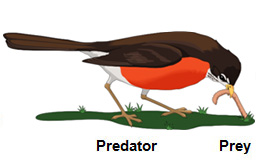
Organisms in the environment do not live in isolation; they interact with one another. We say that organisms are interdependent upon one another because they depend on each other for food, shelter, etc.

Many of the interactions among species occur because one animal eats another. We call this relationship predator and prey or predation. The organism that is eaten is called the prey. The organism that eats the prey is called the predator. When a bird eats a worm, the worm is the prey and the bird is the predator.
An organism can be both a predator and a prey. Can you determine which organisms are both a predator and prey?
![]() Click on each animal to see if it is classified as a predator, prey, or both.
Click on each animal to see if it is classified as a predator, prey, or both.
Why are humans often called the ultimate predators?
Parasitism or parasite and host is another type of interaction that occurs in many environments. Many people often mistakenly think parasitism and predation are the same thing.
Parasitism is a relationship in which one organism gets its nutrients from another organism. The organism that benefits by obtaining the nutrients is called the parasite. The organism that provides the nutrients is called the host. Some parasites live outside the host's body (ectoparasites), and other parasites live inside the host's body (endoparasites). Common parasites are fleas and ticks.
The main difference between parasitism and predation is that the host does not always die. The host is weakened by the parasite. Sometimes the host is so weakened that it dies but not always.
![]() Click on the following images to learn more about parasitic relationships.
Click on the following images to learn more about parasitic relationships.
Sources for images used in this section, from top to bottom: